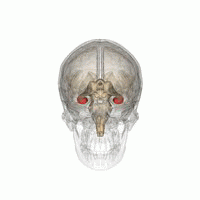
Photo from wikipedia
Identification of primate hippocampal subfields in vivo using structural MRI imaging relies on variable anatomical guidelines, signal intensity differences, and heuristics to differentiate between regions (Yushkevich et al., 2015a). Thus,… Click to show full abstract
Identification of primate hippocampal subfields in vivo using structural MRI imaging relies on variable anatomical guidelines, signal intensity differences, and heuristics to differentiate between regions (Yushkevich et al., 2015a). Thus, a clear anatomically‐driven basis for subfield demarcation is lacking. Recent work, however, has begun to develop methods to use ex vivo histology or ex vivo MRI (Adler et al., 2014; Iglesias et al., 2015) that have the potential to inform subfield demarcations of in vivo images. For optimal results, however, ex vivo and in vivo images should ideally be matched within the same healthy brains, with the goal to develop a neuroanatomically‐driven basis for in vivo structural MRI images. Here, we address this issue in young and aging rhesus macaques (young n = 5 and old n = 5) using ex vivo Nissl‐stained sections in which we identified the dentate gyrus, CA3, CA2, CA1, subiculum, presubiculum, and parasubiculum guided by morphological cell properties (30 μm thick sections spaced at 240 μm intervals and imaged at 161 nm/pixel). The histologically identified boundaries were merged with in vivo structural MRIs (0.625 × 0.625 × 1 mm) from the same subjects via iterative rigid and diffeomorphic registration resulting in probabilistic atlases of young and old rhesus macaques. Our results indicate stability in hippocampal subfield volumes over an age range of 13 to 32 years, consistent with previous results showing preserved whole hippocampal volume in aged macaques (Shamy et al., 2006). Together, our methods provide a novel approach for identifying hippocampal subfields in non‐human primates and a potential ‘ground truth’ for more accurate identification of hippocampal subfield boundaries on in vivo MRIs. This could, in turn, have applications in humans where accurately identifying hippocampal subfields in vivo is a critical research goal.
Journal Title: Hippocampus
Year Published: 2019
Link to full text (if available)
Share on Social Media: Sign Up to like & get
recommendations!